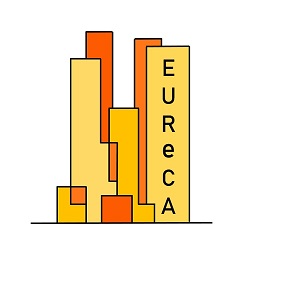The Energy Urban Resistance Capacitance Approach provides an efficient and reliable Urban Building Energy Modeling platform, entirely developed in Python, aiming at simulating and predicting cities and urban areas energy consumption. The tool exploits a bottom-up modeling methodology, creating simple and useful dynamic building energy models.
This research project has been developed within the BETALAB research group of the University of Padua, Italy.
The tool is distributed via the GitHub repository. As first step, you must create a new conda or venv environment. You can name it eureca.
conda create -n eureca python=3.9
and activate it:
conda activate eureca
Then clone the following package in a separate folder:
git clone https://github.com/BETALAB-team/EUReCA.git
and install it in the same environement:
pip install -e *your_path_to_the_folder/eureca-ubem*
The eureca_ubem/Input folder has some examples files to run the simulation. To simulate cities energy consumption in EUReCA, some input files must be prepared:
- A
weather_data.epwweather file. These files are available at the EnergyPlus website. - A
EnvelopeTypes.xlsxspreadsheet. It includes the thermo-physic properties of building envelopes. An example is available in thematerials_and_construction_test.xlsx - A
Schedules.xlsxspreadsheet. It includes the operational schedules of occupancy, appliances, temperature, humidity setpoints, HVAC usage for different end-uses. Example inSchedules.xlsx. - The
config.jsonfile, which defines the simulation parameters. Example in config.json. - The
city.jsonmodel. See the next section for further info on the alternatives.
Currently, EUReCA can handle two typologies of JSON city models. The recommended methodology consists of importing buildings' geometries via semantic CityJSON files, but also 2D shapefiles, encoded in GeoJSON format, can be exploited to build up the city.
The required attributes are:
- CityJSON:
"End Use": "schedule_type_name", "Envelope": "envelope_type_name", "Heating System": "heating_system_name", "Cooling System": "cooling_system_name" - GeoJSON:
"id": integer, "Name": "name", "End Use": "schedule_archetype_name", "Envelope": "envelope_archetype_name", "Height": float, "Nfloors": integer, "Floors": float, "Heating System": "heating_system_name", "Cooling System": "cooling_system_name"
The strings in the city model's attribute table (End Use and Envelope) must match the labels of the End Uses and Envelope types listed in the Schedules.xlsx and EnvelopeTypes.xlsx.
Heating System and Cooling System must match one of the following items:
List of available heating systems:
- IdealLoad
- CondensingBoiler
- TraditionalBoiler
- Traditional Gas Boiler, Centralized, Low Temp Radiator
- Traditional Gas Boiler, Single, Low Temp Radiator
- Traditional Gas Boiler, Centralized, High Temp Radiator
- Traditional Gas Boiler, Single, High Temp Radiator
- Traditional Gas Boiler, Centralized, Fan coil
- Traditional Gas Boiler, Single, Fan coil
- Traditional Gas Boiler, Centralized, Radiant surface
- Traditional Gas Boiler, Single, Radiant surface
- Condensing Gas Boiler, Centralized, Low Temp Radiator
- Condensing Gas Boiler, Single, Low Temp Radiator
- Condensing Gas Boiler, Centralized, High Temp Radiator
- Condensing Gas Boiler, Single, High Temp Radiator
- Condensing Gas Boiler, Centralized, Fan coil
- Condensing Gas Boiler, Single, Fan coil
- Condensing Gas Boiler, Centralized, Radiant surface
- Condensing Gas Boiler, Single, Radiant surface
- Oil Boiler, Centralized, High Temp Radiator
- Oil Boiler, Single, High Temp Radiator
- Stove
- A-W Heat Pump, Centralized, Low Temp Radiator
- A-W Heat Pump, Single, Low Temp Radiator
- A-W Heat Pump, Centralized, Fan coil
- A-W Heat Pump, Single, Fan coil
- A-W Heat Pump, Centralized, Radiant surface
- A-W Heat Pump, Single, Radiant surface
List of available cooling systems:
- IdealLoad
- SplitAirCooler
- ChillerAirtoWater
- SplitAirConditioner
- A-A split
- A-W chiller, Centralized, Fan coil
- A-W chiller, Centralized, Radiant surface
- A-W chiller, Single, Fan coil
- A-W chiller, Single, Radiant surface
Input folder provides some example for the city of Padua.
After the set up of all input files, you can run the simulation throughout a python file, as following:
import os
import time as tm
# CONFIG FILE LOADING
from eureca_building.config import load_config
load_config("path_to_your_config\\config.json")
from eureca_ubem.city import City
# SET INPUT FILES
weather_file = os.path.join(".","path_to_you_input","weather_file.epw")
schedules_file = os.path.join(".","path_to_you_input","Schedules.xlsx")
materials_file = os.path.join(".","path_to_you_input","materials_and_construction_test.xlsx")
city_model_file = os.path.join(".","path_to_you_input","citymodel.geojson")
# Creation of the City object and simulation
city_geojson = City(
city_model=city_model_file,
epw_weather_file=weather_file,
end_uses_types_file=schedules_file,
envelope_types_file=materials_file,
shading_calculation=True,
output_folder=os.path.join(".","your_output_folder")
)
city_geojson.loads_calculation()
city_geojson.simulate(print_single_building_results=True)
If output_folder=os.path.join(".","your_output_folder") is set, outputs are printed in the output folder.
Each file is a csv with the main output variables of each building.
In case you want to use EUReCA for your own research project, please cite the following paper:
@article{
PRATAVIERA2021544,
title = {EUReCA: An open-source urban building energy modelling tool for the efficient evaluation of cities energy demand},
journal = {Renewable Energy},
volume = {173},
pages = {544-560},
year = {2021},
issn = {0960-1481},
doi = {https://doi.org/10.1016/j.renene.2021.03.144},
url = {https://www.sciencedirect.com/science/article/pii/S0960148121005085},
author = {Enrico Prataviera and Pierdonato Romano and Laura Carnieletto and Francesco Pirotti and Jacopo Vivian and Angelo Zarrella},
keywords = {Urban building energy modelling, Lumped-capacitance thermal networks, Semantic georeferenced data, EUReCA, District simulation}
}
